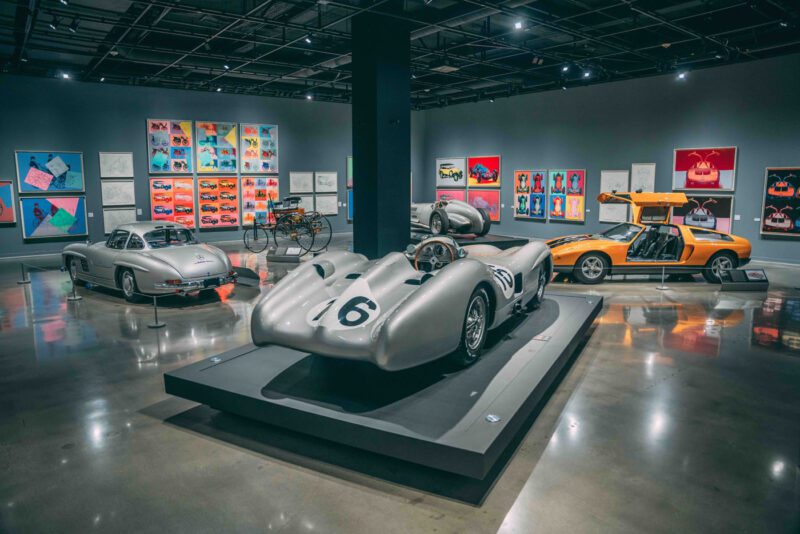For the first time in over 30 years, the series titled Cars: Works from the Mercedes-Benz Art Collection by Andy Warhol visits North America.
It’s available for viewing at the Petersen Automotive Museum in Los Angeles, CA. It features the complete collection of rare artwork and many of the cars that inspired it. This exhibition houses some of the rarest and most valuable vehicles ever, from multiple rare cars brought over from the Mercedes-Benz museum in Germany to a replica of the 1886 Benz Patent-Motorwagen.
We recently took a trip down to the Petersen to check out the exhibition and witness some of this rare metal in person. The collection exists at the Armand Hammer Foundation Gallery on the museum’s first floor. It’s the first room directly to the right of the main entrance. Upon entering, you’re greeted by the artwork collection on the walls alongside five vehicles. However, you’ll want to go to the back, where the exhibit’s description lives on a large black wall.
Mercedes-Benz commissioned Warhol to create the “Cars” series in 1986 to celebrate its 100th anniversary. During that year, Warhol completed a silkscreen print of a 300 SL Coupe, which grabbed the automaker’s attention and inspired the idea for a complete series. The original goal was to create 80 pieces inspired by 20 vehicles spanning the brand’s 100-year history. However, Warhol’s passing in 1987 cut the series short, so only 49 works, 36 screen prints, and 13 drawings exist. In total, these pieces cover eight of the original 20 intended vehicles. Of those eight, five are present in this new exhibition.
1886 Benz Patent-Motorwagen
Starting with what is largely considered the world’s first self-propelled automobile, the Benz Patent-Motorwagen kicks off the exhibit. Designed by Carl Benz in 1886, it was unique as it wasn’t based on a horse-drawn carriage. It features a tube-frame chassis specifically designed to be self-propelled. Thanks to Benz being an avid cyclist, the Patent-Motorwagen also features off-the-shelf bicycle components. Its single-cylinder four-stroke engine developed a whopping 0.9 horsepower. Aside from being considered the world’s first automobile, the Patent-Motorwagen also embarked on the first road trip when in 1888, Bertha Benz made the 106-kilometer journey from Mannheim to Pforzheim with her two sons without Carl knowing.
1937 Mercedes-Benz W 125 Grand Prix Car
Sitting next to the Patent-Motorwagen is perhaps the most striking and impressive vehicle in the collection, the 1937 Mercedes-Benz W 125 Grand Prix Car. Its design was mainly dictated by regulations that stated that a competing car couldn’t weigh over 850 kilograms (1,874 lb.) However, the regulators hadn’t placed a displacement limit. To maximize this loophole, most of the car’s weight comes from its supercharged inline-eight cylinder engine. One look at this race car reveals that it’s essentially a large engine with a driver’s seat and four wheels bolted to it. The W 125 developed nearly 600 horsepower in racing trim while weighing in at a feather-light 1,653 lb. It features a nickel-chrome molybdenum tube frame chassis and an aluminum body.
1954 Mercedes-Benz W 196 R Formula 1 Grand Prix Car
In 1954, Mercedes-Benz unveiled the W 196, set to compete in the 1954 and 1955 Formula One seasons. The German carmaker introduced two variants of the W 196, an open-wheel car and a streamlined variant. The latter pictured above featured a tubular space frame and a body shaped in a wind tunnel. Thanks to unique springless desmodromic valves, its straight-eight produced 257 hp, giving Mercedes-Benz a considerable advantage over its rivals. While the W 196 won nine of the 12 races it ran between 1954 and 1955, the streamlined variant took three of those wins. These victories remain the only three times a closed-wheel vehicle has won in Formula One history.
1954 Mercedes-Benz 300 SL Coupe
Stepping away from the race cars, the exhibition also features a 1954 Mercedes-Benz 300 SL Coupe, one of the most instantly-recognizable cars ever produced. It’s based on a race car from 1952 called the 300 “Sports Leicht” and is the first road-going sports car produced by Mercedes-Benz after the second world war. It’s also the first production passenger car to feature mechanical direct fuel injection, which allowed its three-liter straight-six to deliver up to 240 hp. Weighing in at 3,300 lb, its boosted power output allowed it to reach 163 mph, making it the world’s fastest car at the time. Its tubular space frame construction meant there wasn’t enough space left for conventional doors, so it required doors that opened upwards, just like its racing predecessor.
1970 Mercedes-Benz Type C 111-II Experimental Vehicle
Following the 300 SL “Gullwing,” Mercedes-Benz began work on a potential successor. It completed the first C 111 prototype in 1969, and its primary purpose was to break away from the traditional and experiment with new technologies. On the styling front, it featured a wedge shape, originally made popular by the Lamborghini Marzal concept in 1967. However, its fiberglass body tied back to the 300 SL with its vertical doors. A three-rotor Wankel engine originally powered it. However, the C 111-II pictured above originally featured a four-rotor Wankel engine. The specific vehicle on display houses a V8 engine intended to benchmark against the rotary power plant. While the C 111 eventually spawned a C112 successor in the early 1990s, no road-going versions made it to market.
Surrounding these impressive vehicles is the complete collection of artwork by Warhol, along with original sketches and drawings. Although the remaining three cars aren’t present, the works depicting them are. These include a 1886 Daimler Motor Carriage, 1902 Benz Mylord Coupe, and a 1925 Mercedes-Benz Type 400 Tourenwagen. As an additional display, the Petersen Museum also hosts Warhol’s personal 1974 Rolls-Royce Silver Shadow just outside the main exhibition.
To learn more about the exhibition, please visit the link below.
